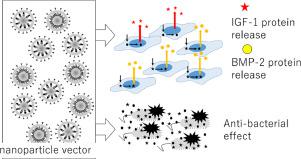Acta Biomaterialia ( IF 9.4 ) Pub Date : 2020-11-07 , DOI: 10.1016/j.actbio.2020.11.003 Chen Xiang 1 , Taichi Tenkumo 1 , Toru Ogawa 1 , Yoshiaki Kanda 1 , Keisuke Nakamura 2 , Midori Shirato 2 , Viktoriya Sokolova 3 , Matthias Epple 3 , Yuya Kamano 4 , Hiroshi Egusa 4 , Keiichi Sasaki 1

|
Protamine-coated multi-shell calcium phosphate (CaP) was developed as a non-viral vector for tissue regeneration therapy. CaP nanoparticles loaded with different amounts of plasmid DNA encoding bone morphogenetic protein 2 (BMP-2) and insulin-like growth factor 1 (IGF-1) were used to treat MC3T3E1 cells, and the yield of the released BMP-2 or IGF-1 was measured using ELISA 3 days later. Collagen scaffolds containing CaP nanoparticles were implanted into rat cranial bone defects, and BMP-2 and IGF-1 yields, bone formation, and bone mineral density enhancement were evaluated 28 days after gene transfer. The antibacterial effects of CaP nanoparticles against Streptococcus mutans and Aggregatibacter actinomycetemcomitans increased with an increase in the protamine dose, while they were lower for Staphylococcus aureus and Porphyromonas gingivalis. In the combination treatment with BMP-2 and IGF-1, the concentration ratio of BMP-2 and IGF-1 is an important factor affecting bone formation activity. The calcification activity and OCN mRNA of MC3T3E1 cells subjected to a BMP-2:IGF-1 concentration ratio of 1:4 was higher at 14 days. During gene transfection treatment, BMP-2 and IGF-1 were released simultaneously after gene transfer; the loaded dose of the plasmid DNA encoding IGF-1 did not impact the BMP-2 or IGF-1 yield or new bone formation ratio in vitro and in vivo. In conclusion, two growth factor-releasing systems were developed using an antibacterial gene transfer vector, and the relationship between the loaded plasmid DNA dose and resultant growth factor yield was determined in vitro and in vivo.
中文翻译:

利用抗菌磷酸钙纳米粒子实现基因转染,增强再生治疗
鱼精蛋白涂层多壳磷酸钙 (CaP) 被开发为用于组织再生治疗的非病毒载体。载有不同数量的编码骨形态发生蛋白 2 (BMP-2) 和胰岛素样生长因子 1 (IGF-1) 的质粒 DNA 的 CaP 纳米颗粒用于治疗 MC3T3E1 细胞,释放的 BMP-2 或 IGF- 3天后使用ELISA测量1。将含有 CaP 纳米颗粒的胶原支架植入大鼠颅骨缺损处,并在基因转移 28 天后评估 BMP-2 和 IGF-1 产量、骨形成和骨矿物质密度增强。CaP纳米粒子对变形链球菌和伴放线菌的抗菌作用随着鱼精蛋白剂量的增加而增加,而金黄色葡萄球菌和牙龈卟啉单胞菌的剂量较低。在与BMP-2和IGF-1联合治疗中,BMP-2和IGF-1的浓度比是影响骨形成活性的重要因素。BMP-2:IGF-1 浓度比为 1:4 的 MC3T3E1 细胞的钙化活性和 OCN mRNA 在 14 天时更高。在基因转染处理过程中,BMP-2和IGF-1在基因转染后同时释放;编码 IGF-1 的质粒 DNA 的加载剂量不影响体外和体内BMP-2 或 IGF-1 产量或新骨形成率. 总之,使用抗菌基因转移载体开发了两种生长因子释放系统,并在体外和体内确定了加载的质粒 DNA 剂量与所得生长因子产量之间的关系。











































 京公网安备 11010802027423号
京公网安备 11010802027423号